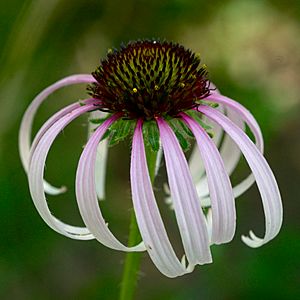Sanguine purple coneflower facts for kids
Quick facts for kids Sanguine purple coneflower |
|
|---|---|
 |
|
| Scientific classification | |
| Genus: |
Echinacea
|
| Species: |
sanguinea
|
| Synonyms | |
|
|
The Echinacea sanguinea, also known as the sanguine purple coneflower, is a beautiful plant that grows year after year. It's a type of herbaceous perennial, which means its stems die back in winter, but its roots stay alive to grow new stems in spring. This plant is native to warm, open areas like sandy fields, pine woods, and prairies. You can find it in the eastern part of Texas, southeastern Oklahoma, all of Louisiana, and southwestern Arkansas. It's the Echinacea species that grows furthest south. The word sanguinea comes from Latin and means "blood," which describes the color of its petals.
About the Sanguine Purple Coneflower
The sanguine purple coneflower can grow quite tall, reaching up to 120 centimeters (about 3 feet). It usually has one main stem that doesn't branch out.
What It Looks Like
The leaves of this plant are usually found close to the ground. They are long and narrow, about 10 to 25 centimeters (4 to 10 inches) long and 6 millimeters (about ¼ inch) wide. The leaves higher up on the stem often have long, soft hairs.
Each stem has a single flower head. This flower head is rose-pink to a pale purple color. It can be up to 5 centimeters (2 inches) long and 12 millimeters (½ inch) wide. The flower has 10 to 20 ray flowers, which are like the petals you see on a daisy. These ray flowers droop downwards, giving the flower a unique look.
The center of the flower is shaped like a cone and is about 2.5 centimeters (1 inch) tall. This cone is purplish-brown on the outside and turns greenish towards the middle. It holds many tiny disc florets, which are the small flowers that make up the center of the cone.

